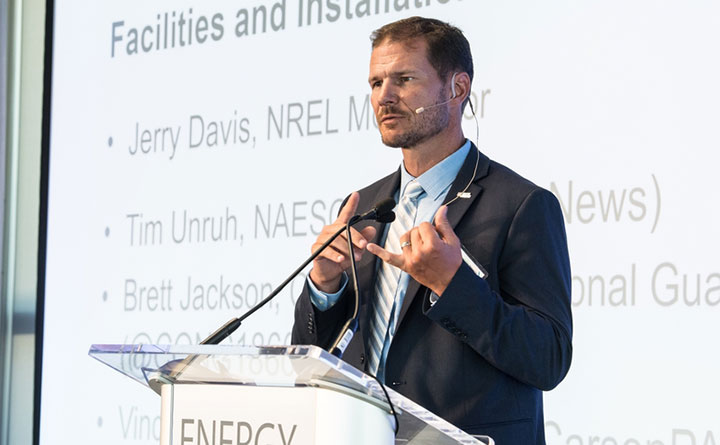Jerry Davis Q&A: Cutting-Edge Research, Microgrids for U.S. Military, and Ultramarathons
Jerry Davis works with the U.S. Department of Defense (DoD) to develop renewable energy technologies for military operations and installations. Davis is a graduate of the U.S. Naval Academy and joined the National Renewable Energy Laboratory (NREL) in 2010, where he is a laboratory program manager in NREL’s Innovation, Partnering, and Outreach directorate. Davis sat down with us to talk about his work on bringing advanced microgrid technologies and cybersecurity measures to support DoD and mission readiness. The following has been edited for length.
Talk a little bit about your background and how you came to NREL.

I kind of grew up in the Navy. I started off enlisting and then got an appointment to the U.S. Naval Academy. After that, I went into Naval nuclear power and became an officer. That was my introduction into engineering and energy.
I started learning about renewables and seeing, from both a business case and a mission case, that the military would begin adopting renewable technologies. I came to the laboratory in 2010 as a biomass power engineer at the same time NREL was starting a strategic initiative supporting DoD, and Navy work in particular. We were helping to develop energy projects for them within NREL’s Integrated Applications Center, and we have now expanded efforts NREL-wide.
Tell us about the connections of your DoD work to ESI.
I work across the laboratory, and Energy Systems Integration (ESI) is the top directorate that aligns with DoD’s interests in power systems, resilience, cybersecurity, and the whole grid-edge theme, especially as these relate to the security of DoD installations on military support bases and communities like Fort Carson and the U.S. Air Force Academy [in Colorado Springs]. DoD is recognizing that their ability to maintain mission readiness is almost directly linked to their surrounding community’s energy resilience and planning. For example, a lot of service members live off-site, and a lot of utilities come from off-site. If the community isn’t resilient, then the base isn’t going to be resilient. A lot of ESI work directly relates to this kind of installation support of the military.
What projects are you excited about?
DoD is interested in cutting-edge research in a variety of areas that NREL can support, from space-based solar power to the use of biological processes to upcycle waste products in the field. The prevalence of packaging from supplies, such as Meals Ready-to-Eat (MREs), creates a logistics burden from disposal needs, but the military is exploring ways in which MRE wrappers could be converted into necessary products such as rifle oil. It’s a double win, reducing the solid waste stream and resupply requirements at the same time.
Cybersecurity is also huge when it comes to using smart technologies and advanced microgrids. Another project is developing a predictive-control approach for a microgrid that uses artificial intelligence to analyze upcoming loads and profiles. We can also connect with weather data to forecast renewable resource availability and maximize distributed energy resources (DERs). NREL is world class in optimizing the performance of DERs, and cybersecurity rounds out that research, ensuring those solutions are secure. This is a pretty cool area of research that also supports DoD.
Looking forward, what are the biggest challenges you anticipate when it comes to ESI research?
The challenge is creating visibility for DoD in the DOE laboratory system, so DoD can see how the capabilities that we have—that have been funded by DOE for decades—are applicable to their energy needs. For example, the Vehicle Technologies Office at DOE has invested tens of millions of dollars in battery modeling and simulation for vehicles. Until recently, DoD didn’t realize that we had that capability, which directly relates to a need that they have for modeling battery performance in the Navy to determine the applicability of different battery technologies for shipboard applications. So, a big part of my role is trying to connect those dots.
What are your interests outside of NREL?
I love spending time with my family. We’re up here in the mountains, so we love to cross-country ski, downhill ski, and do all the regular Summit County stuff.
I also love to run. I’m one of those nut jobs at the lab who does 100-mile ultra runs. I’m signed up for Leadville 100 again this year, and I am trying to find time to ramp up for that.
Last Updated May 28, 2025
